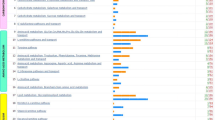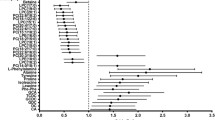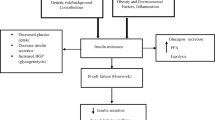Abstract
Type 2 diabetes (T2D) is a complex metabolic disease associated with disturbances in metabolism of carbohydrates, lipids and proteins, and largely under the influence of very complex interactions with genetic and environment factors. High prevalence and increasing number of patients with T2D in the world, represent constant challenge for better elucidation of pathogenic mechanisms which contribute to disease development. This paper summarizes a new molecular biomarker that emerged from recent studies in applied genomics, metabolomics and other modern “omics” technologies as powerful tools in diagnosis of T2D. Metabolomics, in this context, has a special potential since it uses newly developed analytical methods in analyses of wide range of metabolites in biological samples. Numbers of prospective studies have shown that changes in the concentration of some individual amino acids, acylcarnitines, hexoses and phospholipids augment or attenuate risk factors for developing T2D. Recently findings shown that polymorphisms in TCF7L2 gene were strongly associated with increasing risk for T2D development while studies of lipidomics, genomics and transcriptomics identified molecular markers for glucose intolerance and other traits. Some specific gene variations were identified which affected de novo lipogenesis and they were significantly associated with concentrations of palmitic, stearic, palmitoleic and oleic acids, the major saturated and unsaturated fatty acids. Development of new trends in analysis and detection of different metabolites, especially fatty acids and amino acids, along with genetic polymorphisms points out new directions in precise diagnosis and therapy of Type 2 diabetes.


Similar content being viewed by others
Change history
02 December 2019
The article “New molecular biomarkers in precise diagnosis and therapy of type 2 diabetes,” written by S. Mandal, was originally published electronically on the publisher’s Internet portal (currently SpringerLink) on October 26, 2019, with open access.
References
Al-Goblan AS, Al-Alfi MA, Khan MZ. Mechanism linking diabetes mellitus and obesity. Diabetes, Metabolic Syndrome and Obesity: Targets and Therapy. 2014;7:587–91.
Shulman GI. Cellular mechanisms of Insulin resistance. J Clin Invest. 2000;106:171–6.
Hussain A, Hydrie MZI, Claussen B, Asghar S. Type 2 diabetes and obesity: A review. Journal of Diabetology. 2010;2:1–7.
Boucher J, Kleinridders A, Kahn CR. Insulin receptor signaling in normal and insulin-resistant states. Cold Spring Harb Perspect Biol. 2014;6:1–23.
Samuel VT, Shulman GI. The pathogenesis of insulin resistance: integrating signaling pathways and substrate flux. J Clin Invest. 2016;126(1):12–22.
Prasad RB, Groop L. Genetics of Type 2 Diabetes—Pitfalls and Possibilities. Genes. 2015;6:87–123.
Xu J, Zou M-H. Molecular Insights and Therapeutic Targets for Diabetic Endothelial Dysfunction. Circulation. 2009;120:1266–86.
So WY, Ng MCY, Lee SC, Sanke T, Lee HK, Chan JCN. Genetics of type 2 diabetes mellitus. HKMJ. 2000;6(1):69–76.
Brown AE, Walker M. Genetics of insulin resistance and the metabolic syndrome. Curr Cardiol Rep. 2016;18(75):1–8.
American Diabetes Association. Classification and Diagnosis of Diabetes: Standards of Medical Care in Diabetes-2018, Diabetes Care, Volume: 41(Supplement 1), 2018, ppS13–S27
International Diabetes Federation (IDF). Definition and diagnosis of diabetes mellitus and intermediate hyperglycemia, 2006
Stechemesser L, Eder SK, Wagner A, Patsch W, Feldman A, Strasser M, et al. Metabolomic profiling identifies potential pathways involved in the interaction of iron homeostasis with glucose metabolism. Molecular Metabolism. 2017;6:38–47.
Yu Z, Kastenmüller G. he Y, Belcredi P, Möller G, Prehn C, Mendes J, et al. Differences between human plasma and serum metabolite profiles. PloS ONE. 2011;6(7):1–6.
Wopereis S, Radonjic M, Rubingh C, van Erk M, Smilde A, van Duyyvenvoorde W, et al. Identification of prognostic and diagnostic biomarkers of glucose intolerance in ApoE3Leiden mice. Physiol Genomics. 2011;44:293–304.
Clash CB. Metabolomics: an emerging but powerful tool for precision medicine. 2015, Cold Spring Harb Mol Case Stud 1: a000588
Mayeux R. Biomarkers: potential uses and limitations. The American Society for Experimental Neuro Therapeutics. 2004;1:182–8.
Floegel A, Stefan N, Yu Z, Mühlenbruch K, Drogan D, Joost H-G, et al. Identification of serum metabolites associated with risk of type 2 diabetes using a targeted metabolomic approach. Diabetes. 2013;62:639–48.
Du F, Virtue A, Wang H, Yang X-F. Metabolomics analyses for atherosclerosis, diabetes, and obesity. Biomarker Research. 2013;1(17):1–17.
van der Leeuw J, Beulens WJ, van Dieren S, Schalkwijk CG, Glatz JF.C, Hofker MH, Verschuren MW.M, et al. Novel biomarkers to improve the prediction of cardiovascular event Risk in type 2 diabetes mellitus. J Am Heart Assoc. 2016, 5:e003048
Ahiqvist E, Ahluwalia TS, Groop L. Genetics of type 2 diabetes. Clinical Chemistry. 2011;57(2):241–54.
Zhang X, Gao L, Liu Z-P, Chen L. Identifying module biomarker in type 2 diabetes mellitus by discriminative area of functional activity. BMC Bioinformatics. 2015;16(92):1–10.
Zhao Q, Zhang A, Zong W, An N, Zhang H, Luan Y, et al. Exploring potential biomarkers and determining the metabolic mechanism of type 2 diabetes mellitus using liquid chromatography coupled to high-resolution mass spectrometry. RSC Adv. 2017;7:44186.
Prosser GA, Larrouy-Maumus G, de Carvalho LPS. Metabolomics strategies for the identification of new enzyme functions and metabolic pathways. EMBO Reports. 2014;15:657–69.
Scott RA, Scott LJ, Mägi R, Marullo L, Gaulton KJ, Kaakinen M, et al. An expanded genome-wide association study of type 2 diabetes in Europeans. Diabetes. 2017;66:2888–902.
Kaddurah-Daouk R, Weinshilboum RM. Pharmacometabolomics: implications for clinical pharmacology and systems pharmacology. Clin Pharmacol Ther. 2014;95(2):154–67.
Zheng Y, Hu FB. Comprehensive metabolomic profiling of type 2 diabetes. Clinical Chemistry. 2015;61(3):453–5.
Park J-E, Jeong G-H, Lee I-K, Yoon Y-R, Liu K-H, Gu N, et al. A Pharmacometabolomic approach to predict response to metformin in early-phase type 2 diabetes mellitus patients. Molecules. 2018;23(1579):1–13.
Kong H, Liu Y, Zheng L, Wang Q, Zhang Y. One of the crucial proteins to influence type 2 diabetes: the high mobility group A1. Biosci. Biotech. Res. Comm. 2016;9(4):580–6.
Billings LK, Florez JC. The genetics of type 2 diabetes: what we learned from GWAS? Ann N Y Acad Sci. 2010;1212:59–77.
Goh GYS, Winter JJ, Bhanshali F, Doering KRS, Lai R, Lee K, et al. NHR-49/HNF4 integrates regulation of fatty acid metabolism with a protective transcriptional response to oxidative stress and fasting. Aging Cell. 2018;17:1–14.
Mandal S, Causevic A, Prnjavorac B, Semiz S. Non-esterified fatty acids as possible biomarkers in glucose control of prediabetes and type 2 diabetes. J. Res. Pharm. Sci. 2014;1(1):28–38.
Liu L, Li Y, Guan C, Li K, Wang C, Feng R, et al. Free fatty acid metabolic profile and biomarkers of isolated post-challenge diabetes and type 2 diabetes mellitus based on GC–MS and multivariate statistical analysis. Journal of Chromatography B. 2010;878(28):2817–25.
Georgiadi A, Kersten S. Mechanisms of gene regulation by fatty acids. Adv. Nutr. 2012;3:127–34.
Tsoukalas D, Alegakis AK, Fragkiadaki P, Papakonstantinou E, Tsilimidos G, Geraci F, et al. Application of metabolomics part II: Focus on fatty acids and their metabolites in healthy adults. International Journal of Molecular edicine. 2019;43:233–42.
Bi X, Qing Yeo PL, Loo YT, Henry CJ. Associations between circulating fatty acid levels and metabolic risk factors. Journal of Nutrition & Intermediary Metabolism. 2019;15:65–9.
Mandal S, Causevic A, Malenica M, Dujić T, Bego T, Prnjavorac B, et al. Free fatty acids as possible biomarkers in control and progression of prediabetes to type 2 diabetes. Diabetologia. 2012;55(Suppl.1):S260.
Mahendran Y, Cederberg H, Vangipurapu J, Kangas AJ, Soininen P, Kuusisto J, et al. Glycerol and fatty acids in serum predict the development of hyperglycemia and type 2 diabetes in Finnish men. Diabetes Care. 2013;36:3732–8.
Hayakawa J, Wang M, Wang C, Han RH, Jiang Z-Y, Han X. Lipidomic analysis reveals significant lipogenesis and accumulation of lipotoxic components in ob/ob mouse organs. PLEFA. 2017;136:161–9.
Giesbertz P, Padberg I, Rein D, Ecker J, Höfle AS, Spanier B, et al. Metabolite profiling in plasma and tissues of ob/ob and db/db mice identifies novel markers of obesity and type 2 diabetes. Diabetologia. 2015;58:2133–43.
Molnos S, Wahl S, Haid M, Eekhoff E.MW, Pool R, Floegel A, Deelen J, et al. Metabolite ratios as potential biomarkers for type 2 diabetes: a DIRECTstudy. Diabetologia. 2018;61:117–129.
Hertel JK, Johansson S, Midthjell K, Nygård O, Njølstad PR, Molven A. Type 2 diabetes genes-present status and data from Norwefian studies. Norsk Epidemiologi. 2013;23(1):9–22.
Kommoju UJ, Maruda J, Kadarkarai Samy S, Irgam K, Kotla JP, Reddy BM. Association of IRS1, CAPN10, and PPARG gene polymorphisms with type 2 diabetes mellitus in the high-risk population of Hyderabad. India. J Diabetes. 2014;6(6):564–73.
Zhang W, Zhong W, Sun Q, Sun X, Zhou Z. Adipose-specific lipin1 overexpression in mice protects against alcohol-induced liver injury. Scientific Reports. 2017;8(408):1–11.
Kajimoto K, Suemitsu E, Sato Y, Sakurai Y. HarashimaLH. liver-specific silencing of Lipin1 reduces fat mass as well as hepatic triglyceride biosynthesis in mice. Biol. Pharm. Bull. 2016;39:1653–61.
Frühbeck G, Catalán V, Rodríguez A, Ramírez B, Becerril S. Salvador, Colina I, et al. Adiponectin-leptin Ratio is a Functional Biomarker of Adipose Tissue Inflammation. Nutrients. 2019;11(454):1–13.
Abbas S, Raza ST, Ahmed F, Ahmad A, Rizvi S, Mahdi F. Association of genetic polymorphism of PPARγ-2, ACE, MTHFR, FABP-2 and FTO genes in risk prediction of type 2 diabetes mellitus. Journal of Biomedical Science. 2013;20(80):1–8.
Wu JHY, Lemaitre RN. Manichaikul A, Guan W, Tanaka T, Foy M, et al. Genome-wide association study identifies novel loci associated with concentrations of four plasma phospholipid fatty acids in the de novo lipogenesis pathway. Circ Cardiovasc Genet. 2017;6:171–183.
Merino J, Leong A, Liu C-T, Porneala B, Walford GA, von Grotthuss M, et al. Metabolomics insights into early type 2 diabetes pathogenesis and detection in individuals with normal fasting glucose. Diabetologia. 2018;61:1315–24.
Fall T, Xie W, Poon W, Yaghootkar H, Mägi R, Knowles JW, et al. Using genetic variants to assess the relationship between circulating lippids and type 2 diabetes. Diabetes. 2015;64:2676–84.
Oki E, Norde MN, Carioca AA. F, Souza JM.P., Castro IA, Marchioni DM.L., Fisberg RM, et al. Polymorphisms of the TNF-α gene interact with plasma fatty acids on inflammatory biomarker profile: a population-based, cross-sectional study in São Paulo, Brazil. British Journal of Nutrition. 2017;117:1663–73.
Trojnar M, Patro-Małysza J, Kimber-Trojnar Ž. Leszczyńska_Gorzelak B, Mosiewicz J. Associations between Fatty Acid-Binding Protein 4–A Proinflammatory Adipokine and Insulin Resistance, Gestational and Type 2 Diabetes Mellitus. Cells. 2019;8(227):1–15.
Huang MC, Chang WT, Chang HY, Chung HF, Chen FP, Huang YF, et al. FADS gene polymorphisms, fatty acid desaturase activities, and HDL-C in Type 2 diabetes. Int J Environ Res Public Health. 2017;28(6):E572.
Marklund M, Morris AP, Mahajan A. Ingelsson, Lindgren CM, Lind L, Risérus. Genome-wide association studies of estimated fatty acid desaturase activity in serum and adipose tissue in elderly individuals: associations with insulin sensitivity. Nutrients. 2018;10(1791):1–13.
Gromovsky AD, Schugar RC, Brown AL, Helsey RN, Burrows AC, Ferguson D, et al. Δ-5 Fatty acid desaturase FADS1 impacts metabolic disease by balancing proinflammatory and proresolving lipid mediators. Arterioscler Thromb Vasc Biol. 2018;38:218–31.
Lokvancic H, Mandal S, Adilovic M, Sterner M, Gremsperger G, Ahqvist E, et al. association of FADS1 genetic variation with free fatty acid levels and type 2 diabetes-related traits. Diabetologia. 2018; 61(Suppl:1):559.
Dorcely B, Katz K, Jagannathan R, Chiang SS, Oluwadare B, Goldberg IJ, et al. Novel biomarkers for prediabetes, diabetes, and associated complications. Diabetes, Metabolic Syndrome and Obesity: Targets and Therapy. 2017;10:345–61.
Abbasi A. Mendelian randomization studies of biomarkers and type 2 diabetes. Endocrine Connections. 2015;4:249–60.
Yang M, Ni C, Chang B, Jiang Z, Zhu Y, Tang Y, et al. association between serum total bilirubin levels and the risk of type 2 diabetes mellitus. Diabetes Research and Clinical Practice. 2019;152:23–8.
Brahimaj A, Ligthart S, Ghanbari M, Ikram MA, Hofman A, Franco OH, et al. Novel inflammatory markers for incident pre-diabetes and type 2 diabetes: The Rotterdam Study. Eur J Epidemiol. 2017;32:217–26.
Mandal Š, Čaušević A. The correlation between C-reactive protein and regulation of glycemia in type-2 diabetic patients. Bulletin of the Chemists and Technologists of Bosnia and Herzegovina. 2017;48:5–8.
Ng TW. khan AA, Meikle PJ. Investigating the pathogenesis and risk of type 2 diabetes: clinical applications of metabolomics. Clin. Lipidol. 2012;7(6):641–59.
Prattichizzo F, Giuliani A, Ceka A, Rippo M-R, Bonfigli A-R, Testa R, et al. Epigenetic mechanisms of endothelial dysfunction in type 2 diabetes. Clinical Epigenetics. 2015;7(56):1–11.
De Candia P, Spinetti G, Specchia C, Sangalli E, La Sala L, Uccellatore A, et al. A unique plasma microRNA profile defines type 2 diabetes progression. PLoS ONE. 2017;12(12):e0188980.
Yaribeygi H, Katsiki N, Behnam B, Iranpanah H, Sahebkar A. MicroRNAs and type 2 diabetes mellitus: Molecular mechanisms and the effect of antidiabetic drug treatment. Metabolism. 2017;87:48–55.
Wagner JA. Early clinical development of pharmaceuticals for type 2 diabetes mellitus: from preclinical models to human investigation. The Journal of Clinical Endocrinology & Metabolism. 2002;87(12):5362–6.
Newgard CB. Metabolomics and metabolic diseases: where do we stand? Cell Metabolism. 2017;25:43–56.
Author information
Authors and Affiliations
Corresponding author
Ethics declarations
Conflict of interest
The authors declare that they have no conflict of interest.
Additional information
Publisher’s note
Springer Nature remains neutral with regard to jurisdictional claims in published maps and institutional affiliations.
The original version of this article was revised: due to retrospective open access cancellation.
Rights and permissions
About this article
Cite this article
Mandal, S. New molecular biomarkers in precise diagnosis and therapy of Type 2 diabetes. Health Technol. 10, 601–608 (2020). https://doi.org/10.1007/s12553-019-00385-6
Received:
Accepted:
Published:
Issue Date:
DOI: https://doi.org/10.1007/s12553-019-00385-6




